#capuchin saint
Explore tagged Tumblr posts
Text

Saint Lawrence of Brindisi Doctor of the Church 1559-1619 Feast Day: July 21 Patronage: Brindisi, Italy
Saint Lawrence of Brindisi was raised and educated in Italy by the Franciscans. At 16, he entered the Capuchin order, continuing his extensive studies in theology, philosophy, and languages. Talented as a linguist in over six languages, and an orator with a great memory, he was sent all over Europe serving as a peacemaker, chaplain, teacher, evangelist, and writer. He founded convents and monasteries to help serve the Church in troubled times. In 1959, St. Lawrence was declared a Doctor of the Church.
Prints, plaques & holy cards available for purchase here: (website)
51 notes
·
View notes
Text
New icon now listed in my online shop!

Click on the image to see the listing :)
Some details below:
$52.00 (shipping included!)
DIMENSIONS – Approximately 5” x 7.5” x 0.25”
DAMAGE-FREE HANGING – While not included, this wooden icon is flat on the backside which is perfect for hanging with Command Strips. No nails or hooks required!
ORIGINAL ILLUSTRATION – This is one of my illustrations of the St. Pio, more well known as “Padre Pio”. The original was a commissioned piece painted with black gouache. At the top of the icon are hand-painted gold letters that spell out “St. Pio” and surrounding his portrait are white daisies.
BEAUTIFULLY HANDMADE ICON – Each icon is crafted with wood, acrylic paint, and printed paper before being carefully sealed with a UV-protective glossy finish. Each icon is meant to have imperfections due to their unique, unfinished nature so brush strokes will be visible. On the back includes a sticker with my logo, “Cella Bella Illuminations” and my website.
#padre pio#st. pio#franciscan#capuchin friar#catholic art#capuchin saint#catholic saints#catholic artist#catholic gifts#catholic tumblr
7 notes
·
View notes
Text
Veronica’s Veil

At the Shrine of the Holy Face in Manoppello, Italy, visitors see a transparent cloth encased between two glass panes within an ornate silver frame above the sanctuary’s altar.
Once light is shined on the cloth of byssus fiber, the image of a bearded man, eyes open, and mouth seemingly taking a breath is revealed.
Devotees of Manoppello veil claim that it is the so-called “Veronica’s Veil.”
It was secretly moved to the little hilltop town in Abruzzo on orders from Pope Clement VII to protect it following the Sack of Rome in 1527.
Another image of Christ’s face, known as “Veronica’s Veil,” is displayed at St. Peter’s Basilica on the 5th Sunday of Lent each year to bless pilgrims as they approach Holy Week.
Although traditional Stations of Cross include “Veronica wipes face of Jesus,” none of the Gospels recount a woman wiping Jesus’ face as he carries his cross to Calvary.
A pious legend says Veronica later went to Rome to leave the relic with St. Clement, one of early popes.
German journalist Paul Badde is convinced that veil displayed by Vatican for the past 400 years is a copy and that the true veil is in Manoppello.
“Every year on Passion Sunday, they show a hoax, I would say,” Badde told Catholic News Service January 14.
Capuchin friars at Manoppello have been custodians of a veil since 1630.
For centuries, few people outside small town knew of cloth and its image of Jesus. However, Capuchin priest, Father Domenico di Cese, made it his life’s work to spread devotion to Holy Face of Manoppello.
When he first saw veil as a young priest in 1930s, he knelt in shock. The face on the ancient linen looked like the same unidentified man who had rescued him from rubble of a church after a major earthquake in 1915 when he was a child.
Father Cese died in 1978 and it wasn’t until 1999 that veil really caught world’s attention.
That was when Jesuit Father Heinrich Pfeiffer, an art historian at Rome’s Pontifical Gregorian University, announced at press conference that cloth was true “Veil of Veronica.”
He stated that after conducting research, he discovered that the image on the veil could be perfectly superimposed on face of the Shroud of Turin, the relic many believe is Jesus’ burial shroud.
Some devotees maintain that the image’s connection to “Veronica” is not related to a woman who tried to soothe Jesus but is actually form of phrase “vera icona” (true icon).
Capuchin Father Paolo Palombarini, parochial vicar of the shrine, said:
“Both pupils are open. But one can see that the right pupil is more closed than one on the left because this is first instance of the Resurrection and it happened just at it does when we wake up in the morning.”
Vatican does not formally recognize authenticity of relics like Veil of Manoppello or Shroud of Turin.
However, public veneration of such relics by popes often draw attention of faithful.
Such was the case when Pope Benedict XVI became first pope to visit Manoppello shrine in 2006 and venerate the image, Badde said.
He told CNS that Pope Benedict had read his book on the veil and “decided to go there against enormous resistance in Vatican.”
Still, during what Pope Benedict himself described as a “private pilgrimage,” he made no pronouncement about the image.
Addressing priests, religious and pilgrims who packed the shrine, he said those who seek the true face of Christ can find it in their brothers and sisters, “especially poorest and those most in need.”
“If we persevere in our quest for the face of the Lord,” Pope Benedict said, “at the end of our earthly pilgrimage, he, Jesus, will be our eternal joy, our reward and glory forever.”
Badde said, “He was the first pope after more than 400 years to get on his knees in front of this image, that’s what he did. That’s what will remain of his pontificate.”
Pope Benedict’s visit increased attention to the image, which continues to draw more pilgrims each year.
#Veronica’s Veil#Shrine of the Holy Face#Manoppello#Italy#transparent cloth#byssus fiber#Abruzzo#Pope Clement VII#St. Peter’s Basilica#holy week#pilgrims#devotees#stations of the cross#saint clement#vatican#Capuchin friars#Father Domenico di Cese#Pontifical Gregorian University#Father Heinrich Pfeiffer#shroud of turin#ancient relic#Veil of Manoppello#Pope Benedict XVI
4 notes
·
View notes
Text
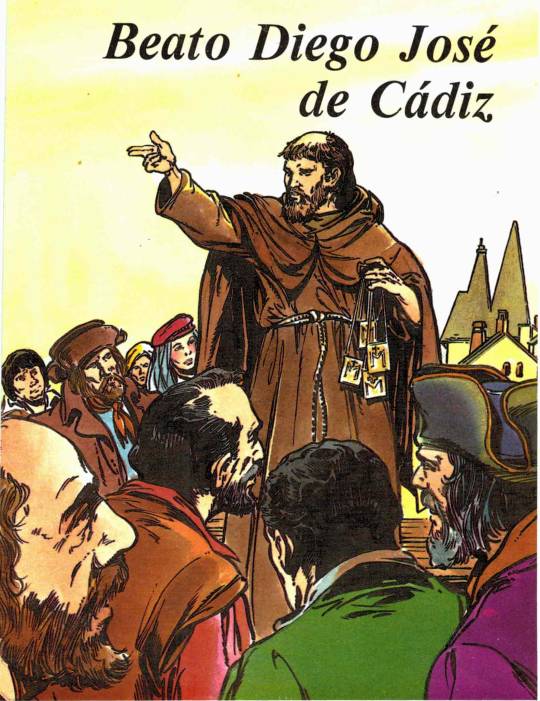
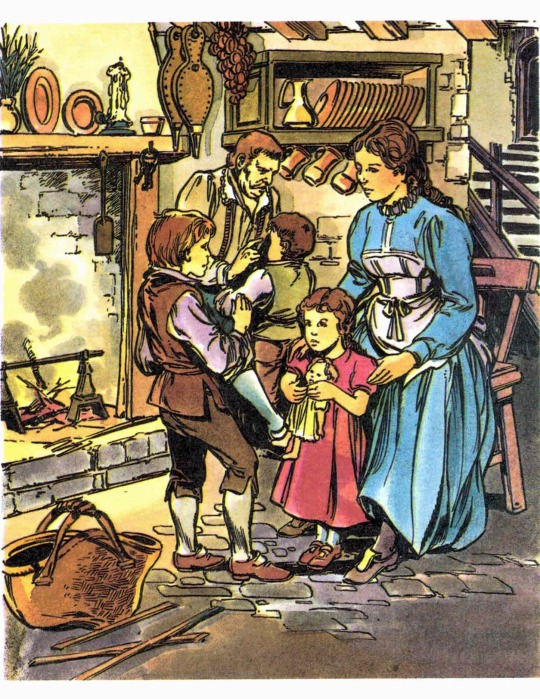

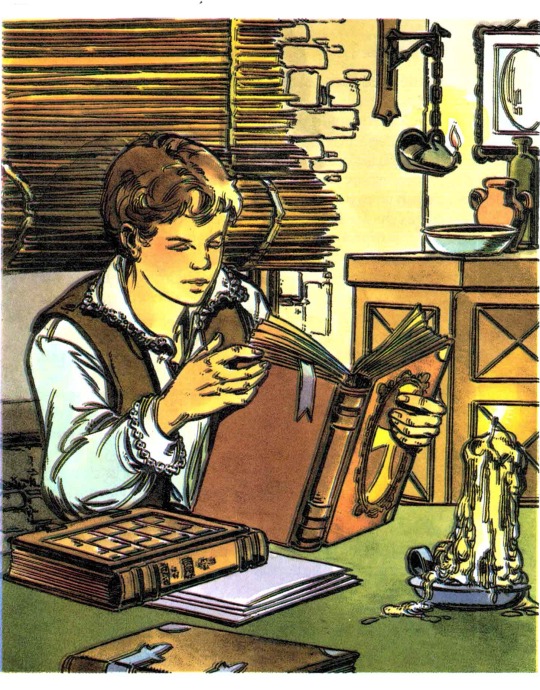
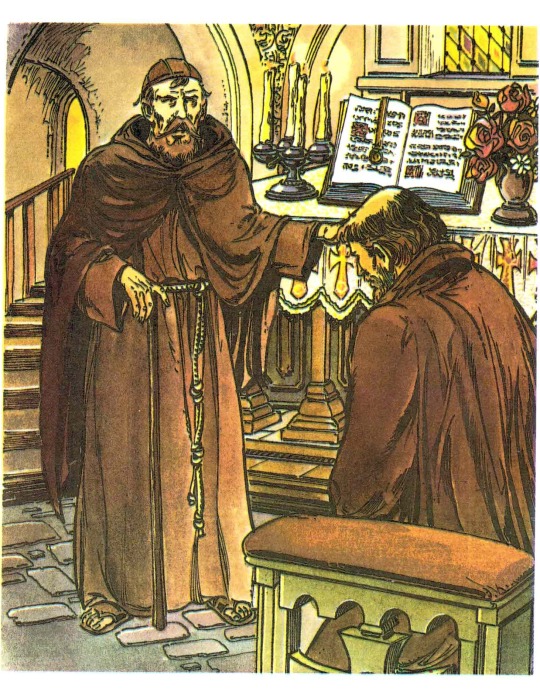
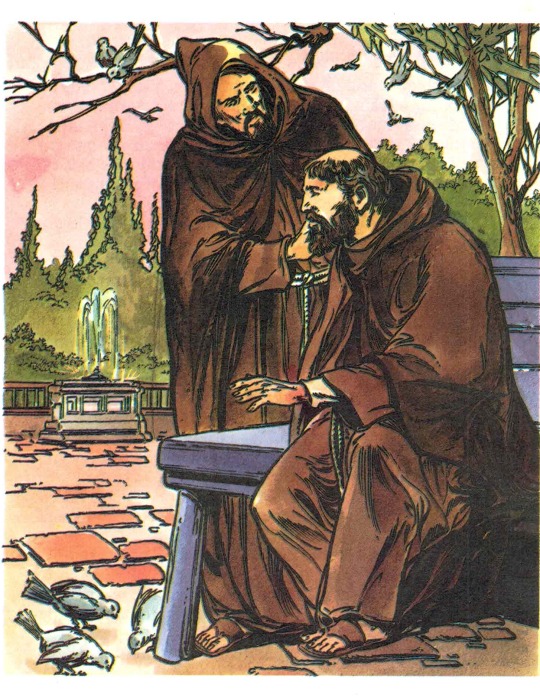
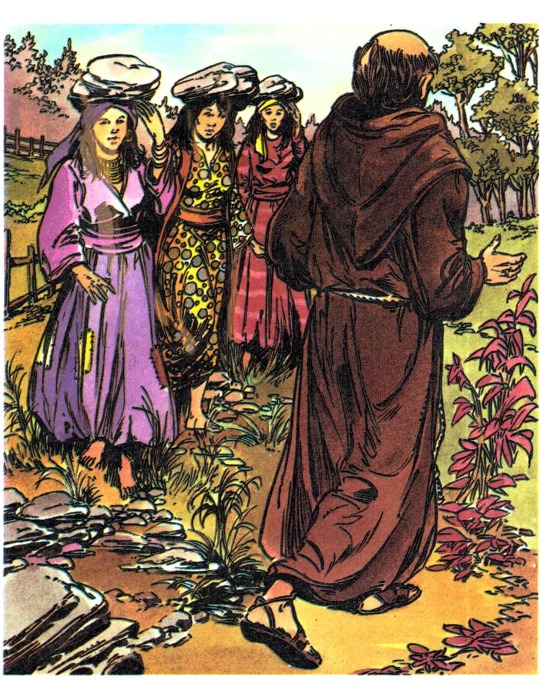
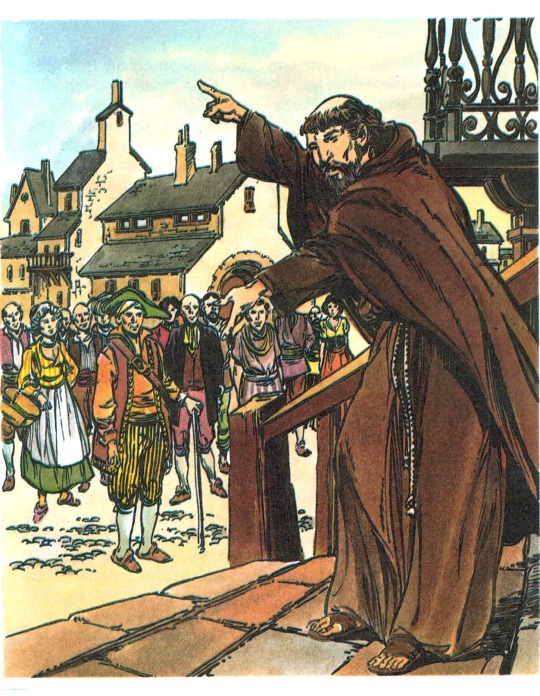

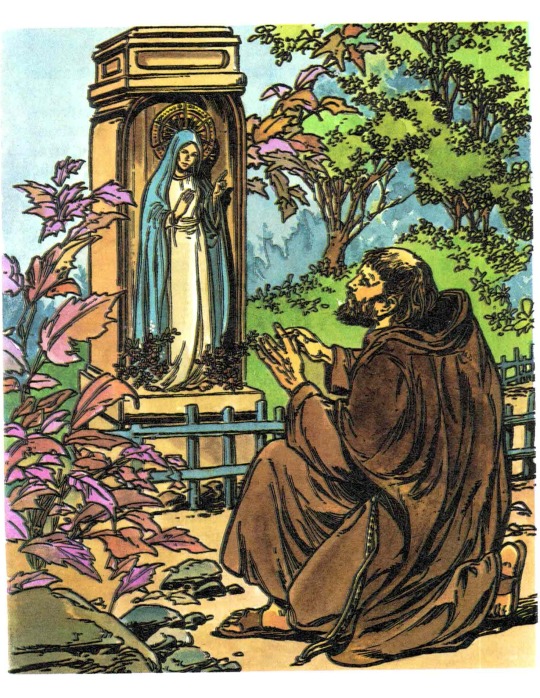
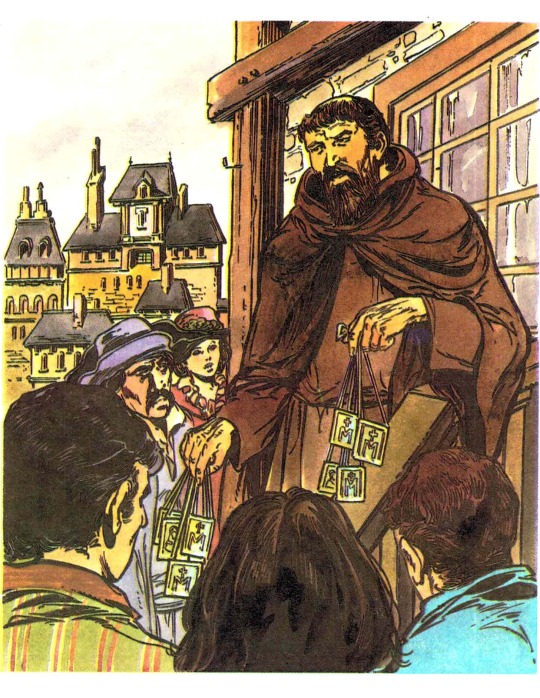
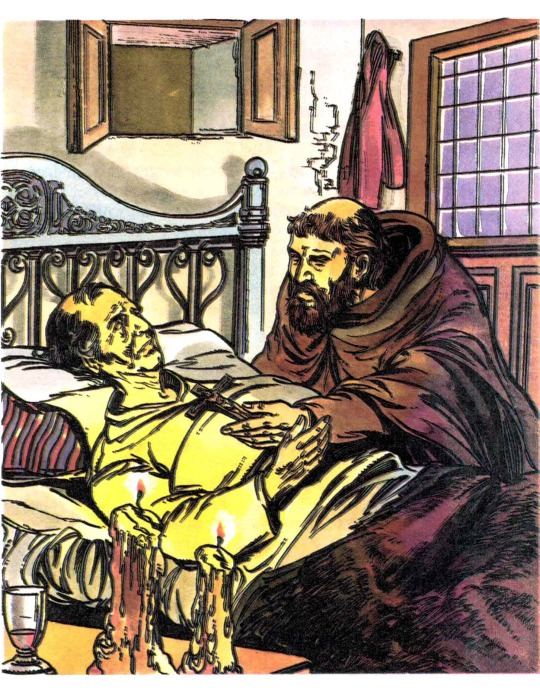
Blessed Diego José de Cádiz Illustrator unknown
0 notes
Text
Some shots of the magnificent interior of Our Dear Lady church (O-L-Vrouwekerk) in Dendermonde, a provincial town in Flanders, Belgium.
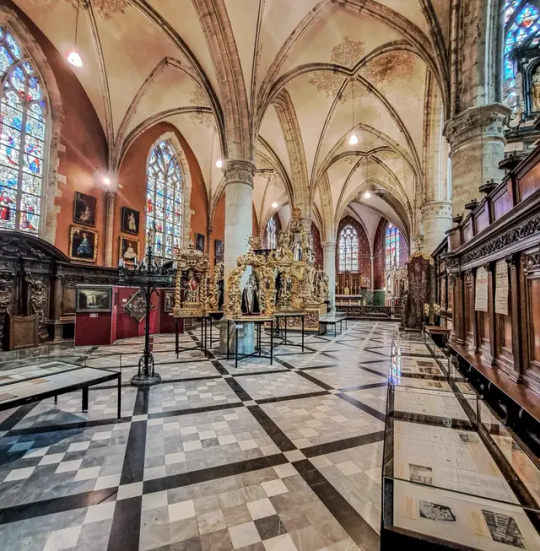
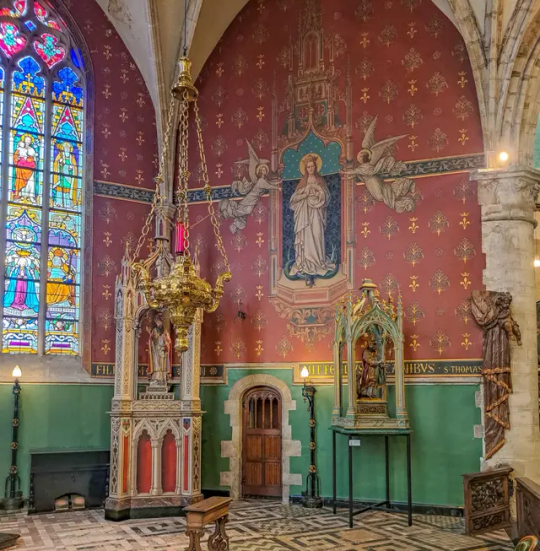
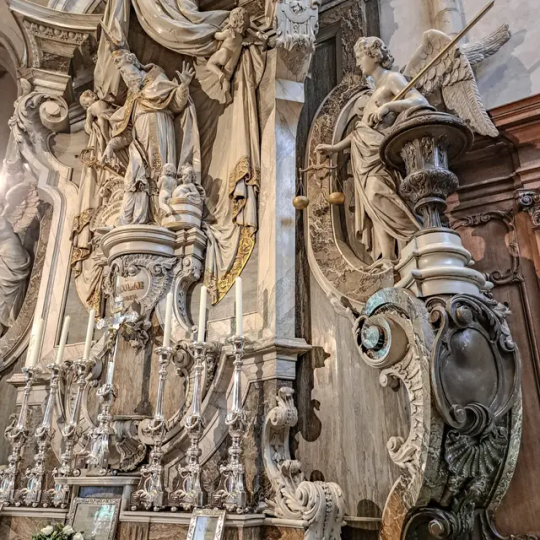
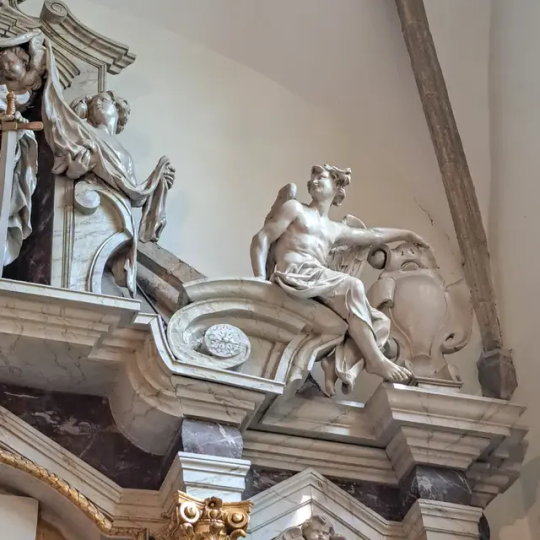
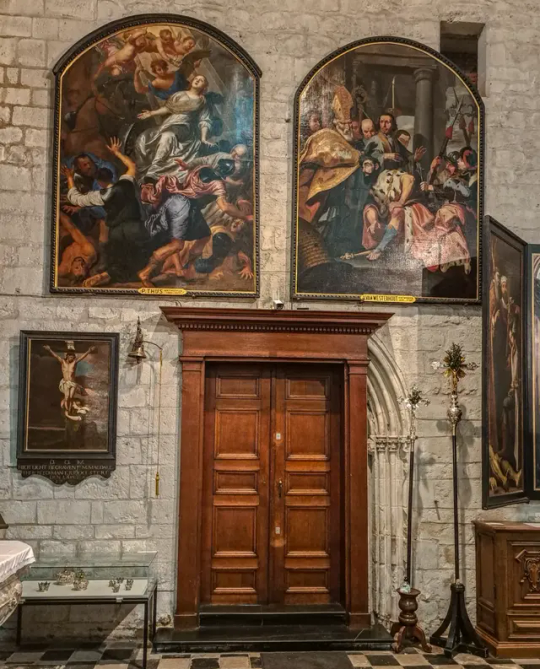

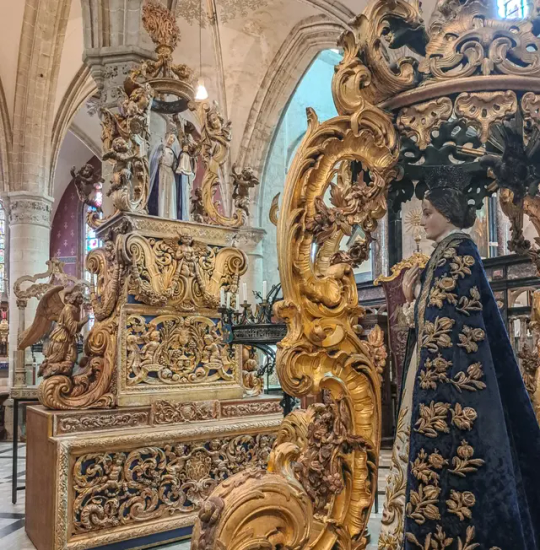
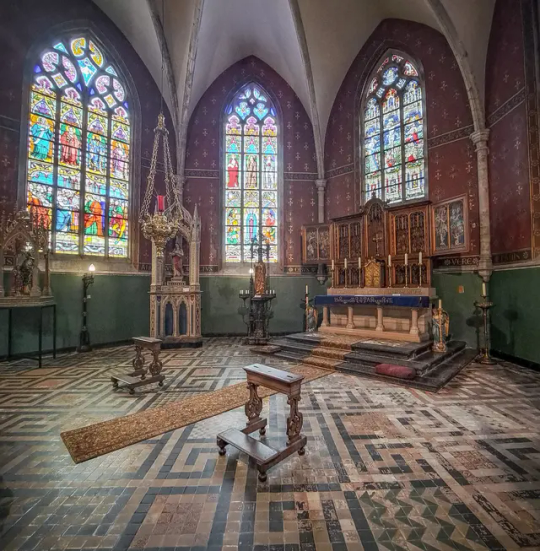
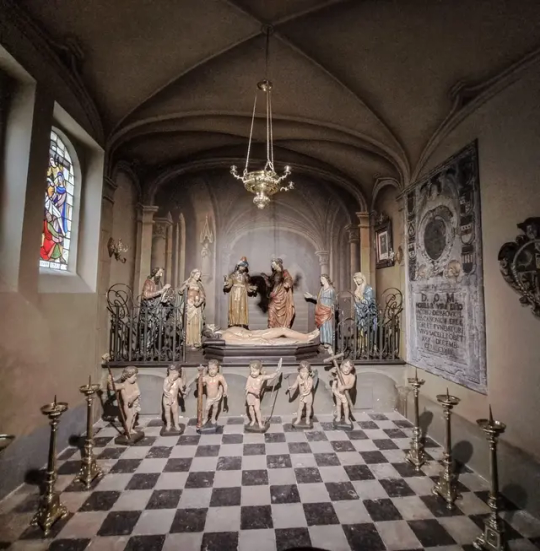
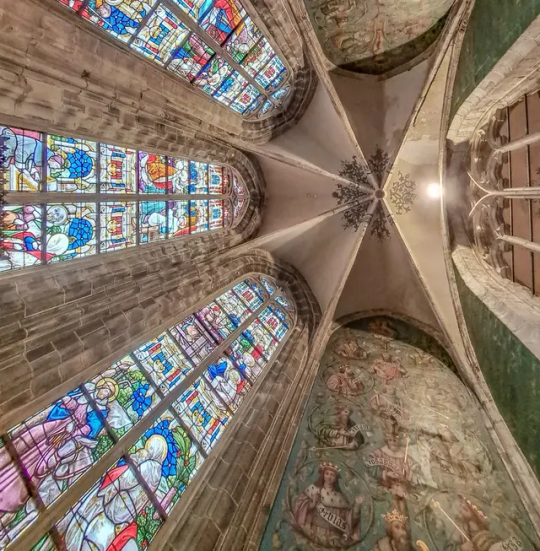
The church has a sculpted Romanesque baptismal font from the 12th century, which comes from Tournai. This is probably the only remnant of the original Romanesque church.
Main altar in early Baroque style, by Antwerp sculptor Hubrecht van den Eynde. This is a monumental portico altar of marble and alabaster, crowned with statues of the patron saints Hilduard and Christiana, and of Christ as Salvator Mundi.
The baroque rood loft dates from 1663. This once closed off the high choir. Artus Quellinus and Mattheüs van Beveren worked on this.
The pulpit, which was made of oak, is also Baroque and dates from 1681. This also belongs to Mattheüs van Beveren. The pulpit is carried by two angels who trample on a heretic who is holding a book.
In addition, you will find numerous other old church furniture, such as confessionals from the 17th century and a communion rail from 1682.
The church contains many valuable paintings, such as Christ on the cross from 1629. This painting painted by Antoon van Dyck was originally intended for the Capuchin Church, which was then located on the Vlasmarkt. After the French Revolution it was taken by the French occupiers and hung in the Louvre in Paijs. After the battle of Waterloo it returned to Dendermonde and was given a place in the Church of Our Lady. In 2024 it became known that it was being restored.
The Adoration of the Shepherds is also a work by Van Dyck. There are also an Ascension of Christ and the Martyrdom of Saint Lawrence, by Gaspar de Crayer, and two wooden panels from a triptych from 1617 by David Teniers the Elder. In 2015, this triptych by David Teniers the Elder, whose center panel disappeared shortly after 1945, was made complete again by a contemporary version of "the transfiguration of Jesus on Mount Tabor". This new painting was painted by Gerolf Van de Perre. In total there are more than 60 paintings in the Church of Our Lady.
There is also, next to the St. Nicholas altar, a statue of a young beggar, attributed to Frans Duquesnoy. Jos De Decker sculpted the granite service altar from 1975.
There is also a church treasure, which includes many silver objects, such as reliquaries, monstrances and the like.
#europe#architecture#historic buildings#historical#belgium#art history#flanders#paintings#flemish art#flemish#flandres#flandern#church#church interior#churches#flemish painter#painting#arte#artwork#art
24 notes
·
View notes
Text
M. Myriel Becomes M. Welcome
Les Mis Letters reading club explores one chapter of Les Misérables every day. Join us on Discord, Substack - or share your thoughts right here on tumblr - today's tag is #lm 1.1.2
The episcopal palace of D—— adjoins the hospital.
The episcopal palace was a huge and beautiful house, built of stone at the beginning of the last century by M. Henri Puget, Doctor of Theology of the Faculty of Paris, Abbé of Simore, who had been Bishop of D—— in 1712. This palace was a genuine seignorial residence. Everything about it had a grand air,—the apartments of the Bishop, the drawing-rooms, the chambers, the principal courtyard, which was very large, with walks encircling it under arcades in the old Florentine fashion, and gardens planted with magnificent trees. In the dining-room, a long and superb gallery which was situated on the ground floor and opened on the gardens, M. Henri Puget had entertained in state, on July 29, 1714, My Lords Charles Brûlart de Genlis, archbishop; Prince d’Embrun; Antoine de Mesgrigny, the capuchin, Bishop of Grasse; Philippe de Vendôme, Grand Prior of France, Abbé of Saint Honoré de Lérins; François de Berton de Crillon, bishop, Baron de Vence; César de Sabran de Forcalquier, bishop, Seignor of Glandève; and Jean Soanen, Priest of the Oratory, preacher in ordinary to the king, bishop, Seignor of Senez. The portraits of these seven reverend personages decorated this apartment; and this memorable date, the 29th of July, 1714, was there engraved in letters of gold on a table of white marble.
The hospital was a low and narrow building of a single story, with a small garden.
Three days after his arrival, the Bishop visited the hospital. The visit ended, he had the director requested to be so good as to come to his house.
“Monsieur the director of the hospital,” said he to him, “how many sick people have you at the present moment?”
“Twenty-six, Monseigneur.”
“That was the number which I counted,” said the Bishop.
“The beds,” pursued the director, “are very much crowded against each other.”
“That is what I observed.”
“The halls are nothing but rooms, and it is with difficulty that the air can be changed in them.”
“So it seems to me.”
“And then, when there is a ray of sun, the garden is very small for the convalescents.”
“That was what I said to myself.”
“In case of epidemics,—we have had the typhus fever this year; we had the sweating sickness two years ago, and a hundred patients at times,—we know not what to do.”
“That is the thought which occurred to me.”
“What would you have, Monseigneur?” said the director. “One must resign one’s self.”
This conversation took place in the gallery dining-room on the ground floor.
The Bishop remained silent for a moment; then he turned abruptly to the director of the hospital.
“Monsieur,” said he, “how many beds do you think this hall alone would hold?”
“Monseigneur’s dining-room?” exclaimed the stupefied director.
The Bishop cast a glance round the apartment, and seemed to be taking measures and calculations with his eyes.
“It would hold full twenty beds,” said he, as though speaking to himself. Then, raising his voice:—
“Hold, Monsieur the director of the hospital, I will tell you something. There is evidently a mistake here. There are thirty-six of you, in five or six small rooms. There are three of us here, and we have room for sixty. There is some mistake, I tell you; you have my house, and I have yours. Give me back my house; you are at home here.”
On the following day the thirty-six patients were installed in the Bishop’s palace, and the Bishop was settled in the hospital.
M. Myriel had no property, his family having been ruined by the Revolution. His sister was in receipt of a yearly income of five hundred francs, which sufficed for her personal wants at the vicarage. M. Myriel received from the State, in his quality of bishop, a salary of fifteen thousand francs. On the very day when he took up his abode in the hospital, M. Myriel settled on the disposition of this sum once for all, in the following manner. We transcribe here a note made by his own hand:—
NOTE ON THE REGULATION OF MY HOUSEHOLD EXPENSES.
For the little seminary - 1,500 livres
Society of the mission - 100”
For the Lazarists of Montdidier - 100”
Seminary for foreign missions in Paris - 200”
Congregation of the Holy Spirit - 150”
Religious establishments of the Holy Land - 100”
Charitable maternity societies - 300”
Extra, for that of Arles - 50”
Work for the amelioration of prisons - 400”
Work for the relief and delivery of prisoners - 500”
To liberate fathers of families incarcerated for debt - 1,000”
Addition to the salary of the poor teachers of the diocese - 2,000”
Public granary of the Hautes-Alpes - 100”
Congregation of the ladies of D——, of Manosque, and of Sisteron,<br> for the gratuitous instruction of poor girls - 1,500”
For the poor - 6,000”
My personal expenses - 1,000”
- ———
Total - 15,000”
M. Myriel made no change in this arrangement during the entire period that he occupied the see of D—— As has been seen, he called it <i>regulating his household expenses</i>.
This arrangement was accepted with absolute submission by Mademoiselle Baptistine. This holy woman regarded Monseigneur of D—— as at one and the same time her brother and her bishop, her friend according to the flesh and her superior according to the Church. She simply loved and venerated him. When he spoke, she bowed; when he acted, she yielded her adherence. Their only servant, Madame Magloire, grumbled a little. It will be observed that Monsieur the Bishop had reserved for himself only one thousand livres, which, added to the pension of Mademoiselle Baptistine, made fifteen hundred francs a year. On these fifteen hundred francs these two old women and the old man subsisted.
And when a village curate came to D——, the Bishop still found means to entertain him, thanks to the severe economy of Madame Magloire, and to the intelligent administration of Mademoiselle Baptistine.
One day, after he had been in D—— about three months, the Bishop said:—
“And still I am quite cramped with it all!”
“I should think so!” exclaimed Madame Magloire. “Monseigneur has not even claimed the allowance which the department owes him for the expense of his carriage in town, and for his journeys about the diocese. It was customary for bishops in former days.”
“Hold!” cried the Bishop, “you are quite right, Madame Magloire.”
And he made his demand.
Some time afterwards the General Council took this demand under consideration, and voted him an annual sum of three thousand francs, under this heading: <i>Allowance to M. the Bishop for expenses of carriage, expenses of posting, and expenses of pastoral visits.</i>
This provoked a great outcry among the local burgesses; and a senator of the Empire, a former member of the Council of the Five Hundred which favored the 18 Brumaire, and who was provided with a magnificent senatorial office in the vicinity of the town of D——, wrote to M. Bigot de Préameneu, the minister of public worship, a very angry and confidential note on the subject, from which we extract these authentic lines:—
“Expenses of carriage? What can be done with it in a town of less than four thousand inhabitants? Expenses of journeys? What is the use of these trips, in the first place? Next, how can the posting be accomplished in these mountainous parts? There are no roads. No one travels otherwise than on horseback. Even the bridge between Durance and Château-Arnoux can barely support ox-teams. These priests are all thus, greedy and avaricious. This man played the good priest when he first came. Now he does like the rest; he must have a carriage and a posting-chaise, he must have luxuries, like the bishops of the olden days. Oh, all this priesthood! Things will not go well, M. le Comte, until the Emperor has freed us from these black-capped rascals. Down with the Pope! [Matters were getting embroiled with Rome.] For my part, I am for Cæsar alone.” Etc., etc.
On the other hand, this affair afforded great delight to Madame Magloire. “Good,” said she to Mademoiselle Baptistine; “Monseigneur began with other people, but he has had to wind up with himself, after all. He has regulated all his charities. Now here are three thousand francs for us! At last!”
That same evening the Bishop wrote out and handed to his sister a memorandum conceived in the following terms:— EXPENSES OF CARRIAGE AND CIRCUIT.
For furnishing meat soup to the patients in the hospital - 1,500 livres
For the maternity charitable society of Aix - 250”
For the maternity charitable society of Draguignan - 250”
For foundlings - 500”
For orphans - 500”
- ——
Total - 3,000”
Such was M. Myriel’s budget.
As for the chance episcopal perquisites, the fees for marriage bans, dispensations, private baptisms, sermons, benedictions, of churches or chapels, marriages, etc., the Bishop levied them on the wealthy with all the more asperity, since he bestowed them on the needy.
After a time, offerings of money flowed in. Those who had and those who lacked knocked at M. Myriel’s door,—the latter in search of the alms which the former came to deposit. In less than a year the Bishop had become the treasurer of all benevolence and the cashier of all those in distress. Considerable sums of money passed through his hands, but nothing could induce him to make any change whatever in his mode of life, or add anything superfluous to his bare necessities.
Far from it. As there is always more wretchedness below than there is brotherhood above, all was given away, so to speak, before it was received. It was like water on dry soil; no matter how much money he received, he never had any. Then he stripped himself.
The usage being that bishops shall announce their baptismal names at the head of their charges and their pastoral letters, the poor people of the country-side had selected, with a sort of affectionate instinct, among the names and prenomens of their bishop, that which had a meaning for them; and they never called him anything except Monseigneur Bienvenu [Welcome]. We will follow their example, and will also call him thus when we have occasion to name him. Moreover, this appellation pleased him.
“I like that name,” said he. “Bienvenu makes up for the Monseigneur.”
We do not claim that the portrait herewith presented is probable; we confine ourselves to stating that it resembles the original.
7 notes
·
View notes
Text

St. Maria Goretti
Patron Saint of Abused Children and Rape Victims
Maria Goretti was born a poor peasant child in Italy in 1890, the third of six children. When she was nine, her family's situation grew even worse, when her father died of malaria. Maria's mother dutifully took her husband's place in the fields, while little Maria took her mother's role in caring for her siblings. The family was able to survive by working the fields of a Count, a job they shared with a man named Giovanni Serenelli and his teenager son Alessandro. Mr. Serenelli kept most of the profits from the farming, leaving the Goretti family quite poor and frequently hungry.
Through all the difficulties, Maria did her best. When neighbors or kindly merchants would give Maria a treat, she would take it home to share with her brothers and sisters. Cheerful and intelligent, Maria was also beautiful, with chestnut hair complementing her delicate features.
On Maria's frequent trips into the nearby village to sell eggs and chickens and to buy supplies for her family, she would visit the shrine of Our Lady of Graces. Her family being too poor to pay for Masses in her father's memory, every night Maria would recite the five Mysteries of the Rosary for the repose of her father's soul.
In June of 1902, 20-year-old Alessandro Serenelli began ordering 11-year-old Maria to perform various difficult chores, none of which could be completed to his satisfaction, and she was often reduced to tears. Alessandro also began making advances on Maria. She rebuffed them all, but, unfortunately, said nothing to her mother, for fear of causing trouble.
On July 5, 1902, Alessandro ordered Maria to mend one of his shirts. As Maria sat mending, caring for her little sister Theresa, Alessandro burst in and motioned Maria into a bedroom. As usual, she refused, but this time, he grabbed her, pulled her into the bedroom, and closed the door. He demanded that she submit to him, but she told him that it would be a sin. Enraged, Alessandro stabbed her 14 times in her heart, lungs, and intestines, and then fled to his bedroom, where he pretended to be asleep.
When little Theresa woke up and began to cry, the family discovered Maria lying on the floor. She survived for 20 hours in the hospital, undergoing surgery without anesthesia. Asked if she forgave her murderer, she replied, "Yes, for the love of Jesus I forgive him...and I want him to be with me in Paradise." She died on July 6.
Unrepentant, Alessandro was convicted, and sentenced to 30 years in prison. In his eleventh year of imprisonment, he had a vision of Maria. He saw a garden. where a young girl, dressed in white, was gathering lilies. She smiled, and came near him, and encouraged him to accept an armful of the lilies. As he accepted them, each lily transformed into a still white flame. Maria then disappeared.
Alessandro's conversion was complete. When he was released from prison after serving 28 years, his first act was to travel to Maria's mother to beg her forgiveness. He then found a job as a gardener in a Capuchin monastery, a job he held for the rest of his life.
Along with 30 other witnesses, Alessandro testified as to Maria's sanctity during her Cause of Beatification. In 1950, she was canonized in a ceremony attended by a quarter million people, including her mother, the first mother ever to see her child canonized.
17 notes
·
View notes
Text
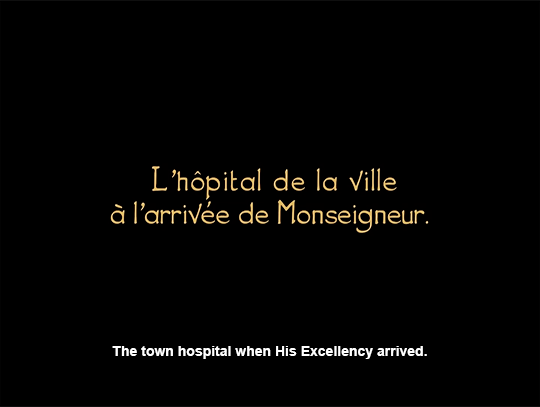
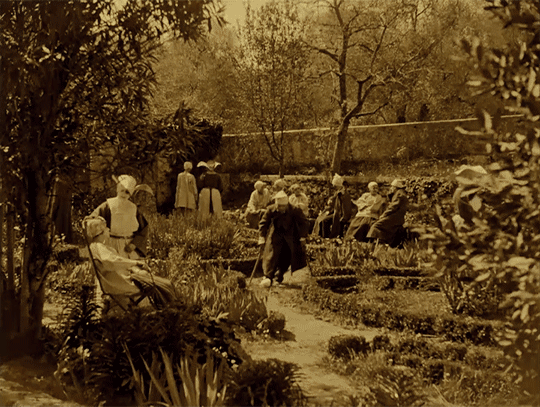

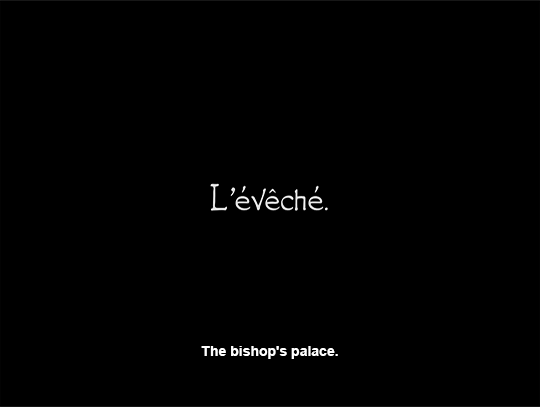


LES MIS LETTERS IN ADAPTATION - M. Myriel Becomes M. Bienvenu, LM 1.1.2 (Les Miserables 1925)
The episcopal palace of Digne adjoins the hospital. The episcopal palace was a huge and beautiful house, built of stone at the beginning of the last century by M. Henri Puget, Doctor of Theology of the Faculty of Paris, Abbé of Simore, who had been Bishop of Digne in 1712. This palace was a genuine seignorial residence. Everything about it had a grand air,—the apartments of the Bishop, the drawing-rooms, the chambers, the principal courtyard, which was very large, with walks encircling it under arcades in the old Florentine fashion, and gardens planted with magnificent trees. In the dining-room, a long and superb gallery which was situated on the ground floor and opened on the gardens, M. Henri Puget had entertained in state, on July 29, 1714, My Lords Charles Brûlart de Genlis, archbishop; Prince d’Embrun; Antoine de Mesgrigny, the capuchin, Bishop of Grasse; Philippe de Vendôme, Grand Prior of France, Abbé of Saint Honoré de Lérins; François de Berton de Crillon, bishop, Baron de Vence; César de Sabran de Forcalquier, bishop, Seignor of Glandève; and Jean Soanen, Priest of the Oratory, preacher in ordinary to the king, bishop, Seignor of Senez. The portraits of these seven reverend personages decorated this apartment; and this memorable date, the 29th of July, 1714, was there engraved in letters of gold on a table of white marble. The hospital was a low and narrow building of a single story, with a small garden.
#Les Mis#Les Miserables#Les Mis Letters#les Mis Letters in Adaptation#LM 1.1.2#Les Mis 1925#Les Miserables 1925#lesmisedit#lesmiserablesedit#lesmis1925edit#lesmiserables1925edit#pureanonedits#the SETS of 1925!!#I wish this kept the order and impact of the brick though.#Oh well.
44 notes
·
View notes
Text
Me: Hugo isn't obsessed with details, you are just lazy fucks
Hugo: In the dining-room, a long and superb gallery which was situated on the ground-floor and opened on the gardens, M. Henri Puget had entertained in state, on July 29, 1714, My Lords Charles Brulart de Genlis, archbishop; Prince d'Embrun; Antoine de Mesgrigny, the capuchin, Bishop of Grasse; Philippe de Vendome, Grand Prior of France, Abbe of Saint Honore de Lerins; Francois de Berton de Crillon, bishop, Baron de Vence; Cesar de Sabran de Forcalquier, bishop, Seignor of Glandeve; and Jean Soanen, Priest of the Oratory, preacher in ordinary to the king, bishop, Seignor of Senez.
#bare minimum of world building#les mis letters#trying to join but with a huge delay#take notes fanfic writers#do you also have a century long backstory of one dining room that a minor oc visited once in the beginning of the story or are you normal#bishop myriel#les miserables#i guess i should tag this as#lm 1.1.2#?#victor hugo#aspa reads les mis
23 notes
·
View notes
Note
Hi! Younger artist here, I just saw your post with all those super cool monster designs and I took a quick stroll through your blog, and I was wondering if you had any specific inspirations for those designs or where you get inspo for character designs in general? Or perhaps some tidbits on how you learned how to make wild designs like that?
Sorry if this is a bit of a big ask, I just think it's really cool and I was curious!
Hello! Thank you for your question and apologies for taking so long to answer, I just got really excited and wanted to be thorough!
My biggest piece of advice is research and develop a visual library of reference material! Your visual library is like a mental database of everything you’ve ever seen in your life, and this is what you can pull from to design concepts.
There are a couple ways to start this as a practice:
Notice what you see! It can be a chair, a sunset, a shoe, the light on a tree, but if you see something you think is beautiful or interesting, mentally make a note of it!
Document what you like! With computers and cameras this is a lot easier to do nowadays, but if you see something interesting to you, document it. You can draw it, or take/save a photo to folder.
Organize it! I highly recommend coming up with a system for referencing back to find things, either through image tags or folders or even a manual filing system.
Pay attention to your personal preferences and experiences. Try to think about what draws you to certain visual elements, identifying them can lead you to more things you like. Also pay attention to what you don’t like and why, it doesn’t necessarily need to be bad or amoral, we all have personal tastes.
Get out of your comfort zone! I recommend trying to see something you’ve never seen before often. Find a new artist, a new genre, research a new type of design movement, go to a new place, etc.
Try to find context for your research! For example, If you really love a specific era of fashion, research that time period and the way historical context informs it. Context can be really important, especially if you are working with references new to you!
Important Note 01: You don’t want to copy or rip-off these things. In my experience the best way to avoid that is to have a lot of reference points for any project and embrace your authentic personal interests, experiences, and identity.
Important Note 02: Like any research, be conscious of primary person vs secondary sources! One is not better than another necessarily, but I find I work my best with a mix of both. I like to start with primary sources and then move to secondary sources, Ie: looking at authentic suits of armor before moving to contemporary armor concept art. You don’t have to do this, it’s just something I find helpful.
Important Note 03: While mostly I’m referring to visual references, audio, music, and writing are also super helpful!
Ok now, how do you curate all that for a project. For those monster illustrations I wanted to explore how color can be horrific. Keywords: Color & Horror. So I start looking through references for things that have the effect I want color wise, vivid and maximalist, and things that I find scary or horrifying. Here are some of the things I knew about or discovered during the research process that had the vibe I wanted.
Notable Influences
Color and Design
Peruvian & Guatemalan Textiles and Traditional Clothing
Spanish Traditional/Folk Clothing
Sammezzano Castle, Italy
Nasir al-Mulk Mosque, Iran
Russian Traditional/Folk Costumes
Fonthill Castle, Pennsylvania
Zhangye National Geopark
Nick Cave - sculpture artist
Lousie Zhang
Magnhild Kennedy - “Damselfrau”
Horror
Catacomb Saints
Capuchin Catacombs of Palermo
Japanese Yokai
Greek & Roman Mythology
Mandrills & Monkeys
Charles Fréger’s Photographs of European Pagan Costuming
Avant Garde Fashion
Alexander McQueen
Vedas by Nicolas Alan Cope and Dustin Edward Arnold
Stephen Jones - Hats
Mummies
Reliquaries
Marina González Eme
Lorenzo Nanni
H.R Giger
Intersections of Color & Horror
Microscopic Imagery
Moths, Beetles & Shrimp
Suspiria (1977)
AJ Fosik
Hungry | Johannes J. Jaruraak
Once you’ve gathered these references in one place (like a moodboard, folder, or Pinterest board) It’s time to pay attention to wear aesthetics intersect, what patterns are coming up, what proportions of color, what textures reoccur, what elements of clothing reoccur, etc.. What relationship do different images have with each other, what emotional effect do they create.
Now that you’ve studied up, it’s time to sketch, try and create things that feel similar to the work you are looking at but not copy it, instead try mixing things together. Experiment! Let your personal style and preferences sink in! Interpret what you’ve learned!
From there, it’s more of a design process, how to use proportion, light, anatomy, perspective, form, repetition, etc, to create the desired effect. Then you refine and refine.
For new or different projects you repeat the process, maybe you use similar points of reference, maybe you go a completely different direction.
Anyway that was long, but I hope it was helpful!
15 notes
·
View notes
Text
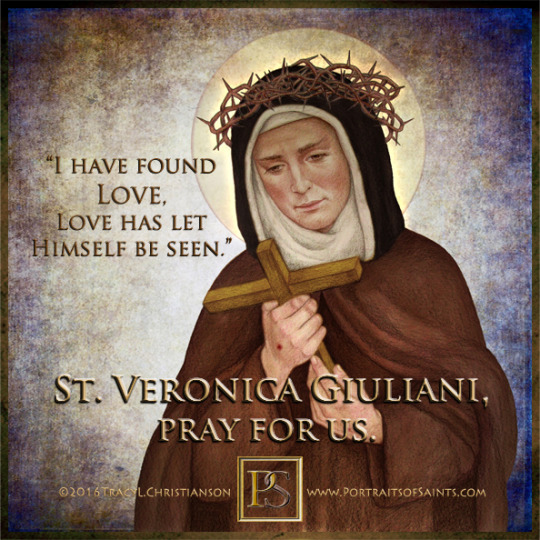
Saint Veronica Giuliani
1660-1727
Feast day: July 9
Saint Veronica, an Italian Capuchin Poor Clare, whose baptismal name was Ursula, is one of the greatest mystics in the Church. Her life was one of the cross and pain, uniting her sufferings with Christ’s passion, death, and resurrection, eventually receiving the stigmata. In her Diary of 22,000 pages, we learn of her ecstatic visions of Jesus, saints, souls in purgatory and of the devil. St. Veronica was devoted to the Eucharist and Sacred Heart, trusting God totally, abandoning herself completely to His will. Her heart is incorrupt to this day.
Prints, plaques & holy cards available for purchase here: (website)
119 notes
·
View notes
Text
Good morrow, friend! I am Brother Euphemius, a monk priest at Farnham Monastary. Although I am ordained, I consider myself a Brother before a Father, as we are all equal under God (as the Capuchins often say, "All of the Fathers are Brothers, but only some of the Brothers are Fathers!"). Please use the confessional whenever you need to. Aside from administering sacraments, I most enjoy studying history, philosophy, and the natural sciences. You may browse my notes if you wish.
OOC Info & Context
he/they pronouns
18+
main blog @grey-ves
Euphemius is a semi-closeted trans man inspired by Saints Marinos and Smaragdus (Euphrosyne)
confessions will be tagged under #confession
“notes” will be tagged under #scriptorium — this will mostly just be me nerding out over medieval history
3 notes
·
View notes
Text
SAINT OF THE DAY (July 6)

July 6 marks the feast day of St. Maria Goretti, a young virgin and martyr whose life is an example of purity and mercy for all Christians.
St. Maria Goretti is best known for her commitment to purity and the courageous defence of her faith at the young age of eleven that made her willing to undergo death rather than participate in a sin against God.
She is also remarkable for the forgiveness she willingly granted her attacker as she lay on her deathbed.
Maria was born on 16 October 1890 in Corinaldo, Italy. Her father, a farmer, died of malaria when she was young, and her mother had to work to support their six children.
Maria took care of the younger children while her mother worked. She prayed the Rosary every night for the repose of her father’s soul.
She grew in grace and maturity. Her cheerful obedience and piety were noticed by those around her.
On 5 July 1902, a neighbouring farm hand, Alessandro Serenelli, tried to rape Maria.
On several prior occasions, Alessandro had harassed Maria with impure advances, all of which she has vehemently rejected.
This time, he locked her in a room and tried to force himself upon her.
She fought against him, shouting, "No! It is a sin! God does not want it!"
She warned him that this was the path towards hell.
When Maria declared that she would rather die than submit to this sin, Alessandro angrily grabbed her and stabbed her 14 times with a knife.
Maria was found bleeding to death and rushed to the hospital.
As she lay dying, she forgave Alessandro for the crime he had committed against her, saying:
"Yes, for the love of Jesus, I forgive him...and I want him to be with me in Paradise."
Although the doctors tried to save her, she died two agonizing days later, only eleven years old.
Alessandro was sentenced to 30 years in prison.
He remained unrepentant until one night, eight years into his prison term, when Maria appeared to him, dressed in white, gathering lilies in a garden.
She smiled, turned towards Alessandro, and offered him the flowers. Each lily he took transformed into a white flame. Then Maria disappeared.
From that moment, Alessandro converted and found peace. He repented of his crime and changed his life.
He was released from prison three years early and begged forgiveness from Maria’s mother, which she duly granted.
Alessandro moved to a Capuchin monastery, working in the garden as a tertiary for the remainder of his life.
He was one of the witnesses who testified to Maria's holiness during her cause of beatification, citing the crime and the vision in prison.
Many miracles were attributed to Maria Goretti after her death.
Pope Pius XII beatified her on 27 April 1947 and canonized on 24 June 1950, becoming the youngest Roman Catholic saint officially recognised by name.
Her feast day is celebrated by the Church on July 6.
She is the patron saint of purity, rape victims, young women, and youth in general.
On her feast day in 2003, Pope John Paul II spoke about St. Maria Goretti at his Sunday Angelus, noting that her life provides an exemplary witness of what it means to be "pure of heart."
"What does this fragile but christianly mature girl say to today's young people, through her life and above all through her heroic death?" asked the Pope.
"Marietta, as she was lovingly called, reminds the youth of the third millennium that true happiness demands courage and a spirit of sacrifice, refusing every compromise with evil and having the disposition to pay personally, even with death, faithful to God and his commandments."
"How timely this message is," the Holy Father continued.
"Today, pleasure, selfishness and directly immoral actions are often exalted in the name of the false ideals of liberty and happiness.
It is essential to reaffirm clearly that purity of heart and of body go together, because chastity ‘is the custodian’ of authentic love."
16 notes
·
View notes
Photo



Saint/s of the Day – 7 August – Blessed Agathangelus Nourry OFM.Cap (1598-1638) and Blessed Cassian Vaz Lopez-Neto OFM Cap (1605-1638) Martyrs, Friars of the Capuchin branch of the Friar’s Minor, Missionaries. Agathangelus was born on 31 July 1598 near Vendome, France and died by being stoned to death or hanged with the cords of his own Habit (records vary) on 7 August 1638 at Dibauria, Abyssinia. Also known as – Agathangelo Noury, Agathangelus of Vendome, Agathangelus Noury, Agathange Noury of Vendôme.
(via Saint/s of the Day – 7 August – Blessed Agathangelus Nourry OFM.Cap (1598-1638) and Blessed Cassian Vaz Lopez-Neto OFM Cap (1605-1638) Martyrs – AnaStpaul)
5 notes
·
View notes
Note
Hi Angel, I would really appreciate prayers!
Saint Pio Prayer
O God, You gave Saint Pio of Pietrelcina, Capuchin priest, the great privilege of participating in a unique way in the Passion of Your Son.
Grant anonymous through his intercession the grace needed the most which they desire; And above all, grant them the grace of living in conformity with the death of Jesus, to arrive at the glory of the resurrection.
Glory be to the Father, and to the Son, and to the Holy Spirit. As it was in the beginning, is now, and ever shall be, world without end. Amen.
Glory be to the Father, and to the Son, and to the Holy Spirit. As it was in the beginning, is now, and ever shall be, world without end. Amen.
Glory be to the Father, and to the Son, and to the Holy Spirit. As it was in the beginning, is now, and ever shall be, world without end. Amen.
3 notes
·
View notes
Text

THE DESCRIPTION OF SAINT PIO OF PIETRELCINA (Padre Pio) Feast Day: September 23
"Pray, hope, and don't worry."
Pio of Pietrelcina was born Francesco Forgione to Grazio Mario Forgione and Maria Giuseppa Di Nunzio, both were peasant farmers in Pietrelcina, a town in the province of Benevento, in the southern region of Campania, Italy on May 25, 1887. He had an older brother, Michele, and three younger sisters, Felicita, Pellegrina, and Grazia (who was later to become a Bridgettine nun).
At a young age, he made the decision to dedicate his life to God, and began a life of penance. One day after listening to a Capuchin friar, who was seeking donations in the countryside, he determined to become a religious priest.
In 1903, he entered the Order of Friars Minor Capuchin, and took the name of Pio. After his ordination seven years later in 1910, he was assigned to the mountain convent of San Giovanni Rotondo, near Foggia, where he remained his whole life. Pio was endowed with exceptional spiritual gifts, such as reading the soul of his penitents, bilocation, experiencing heavenly visions and ecstasies. On the other hand, he was constantly afflicted with physical illness. He believed that the love of God is inseparable from suffering, and that suffering for the sake of God is the sure way to reach him. Pio was often obsessed by the devil, who terrified him with horrible screams and loud noises, or by burning and destroying the furniture of his room, or by brutally beating his body.
In 1910, Padre Pio received the stigmata of Our Lord: red marks appeared in his chest, hands and feet, accompanied by acute pain. At times, he also experienced the pain of the crowning with thorns and of the scourging.
Padre Pio died on September 23, 1968 in San Giovanni Rotondo at the age of 81, after making his last confession and renewing his Franciscan vows, while holding a rosary in his hands. Millions of pilgrims visited San Giovanni Rotondo during his lifetime, and many more afterwards. Pio was beatified by Pope St. John Paul II on May 2, 1999, and canonized as a saint by the same pope on June 16, 2002 at the Vatican.
As Padre Pio had said: "After my death I will do more. My real mission will begin after my death."
14 notes
·
View notes